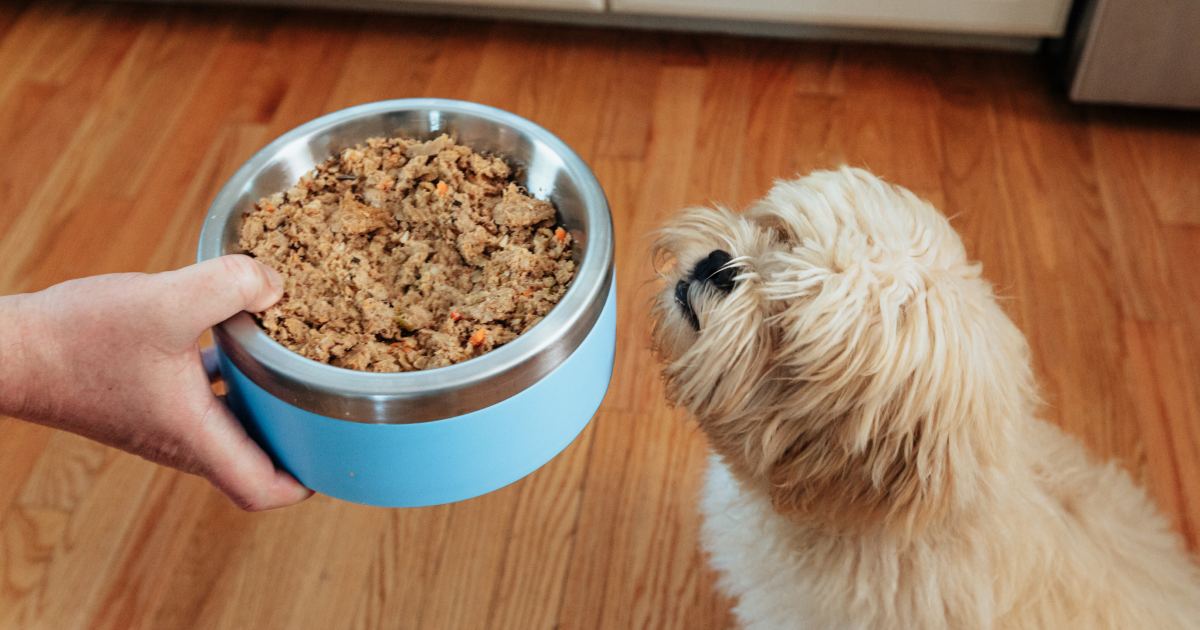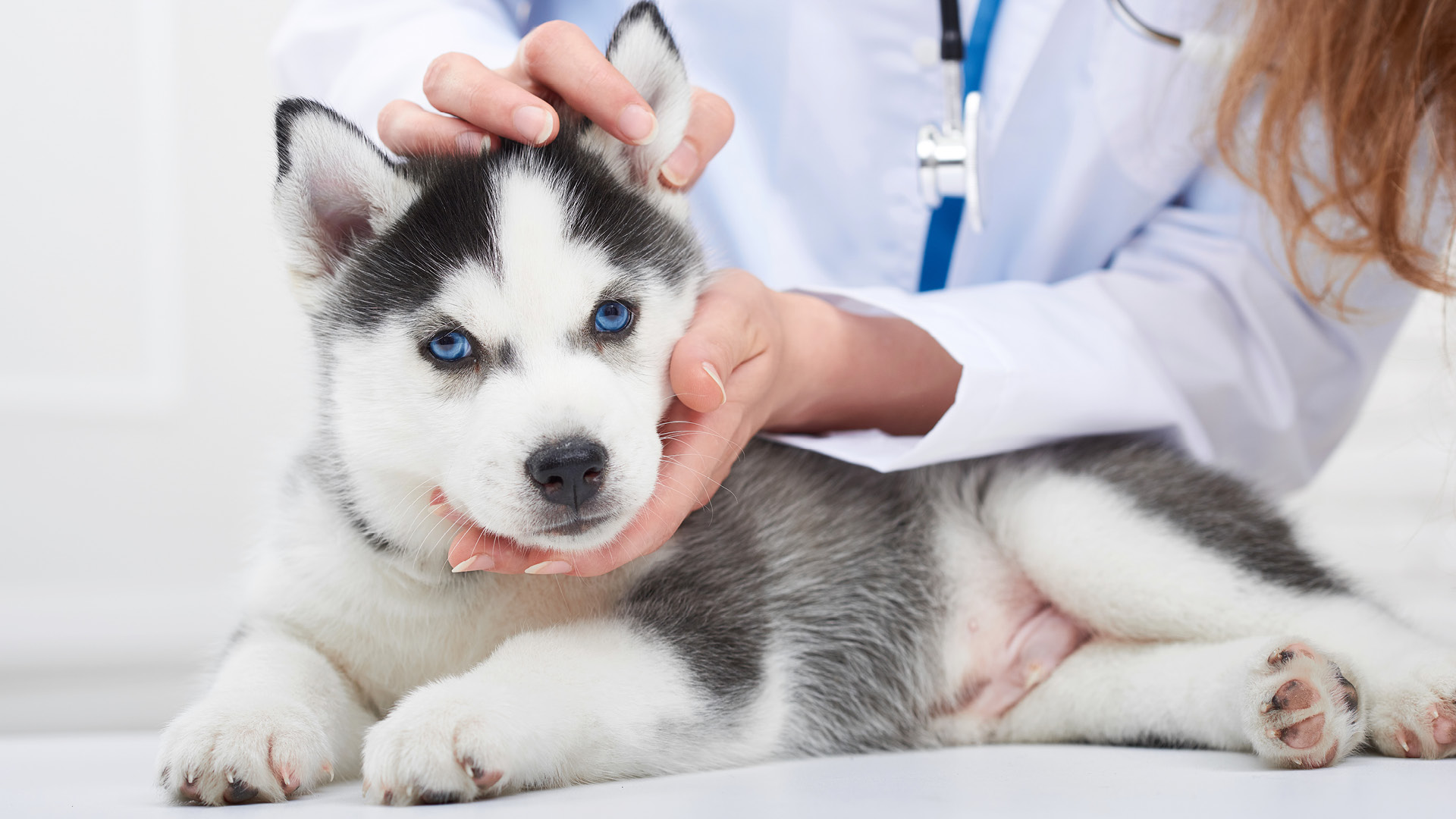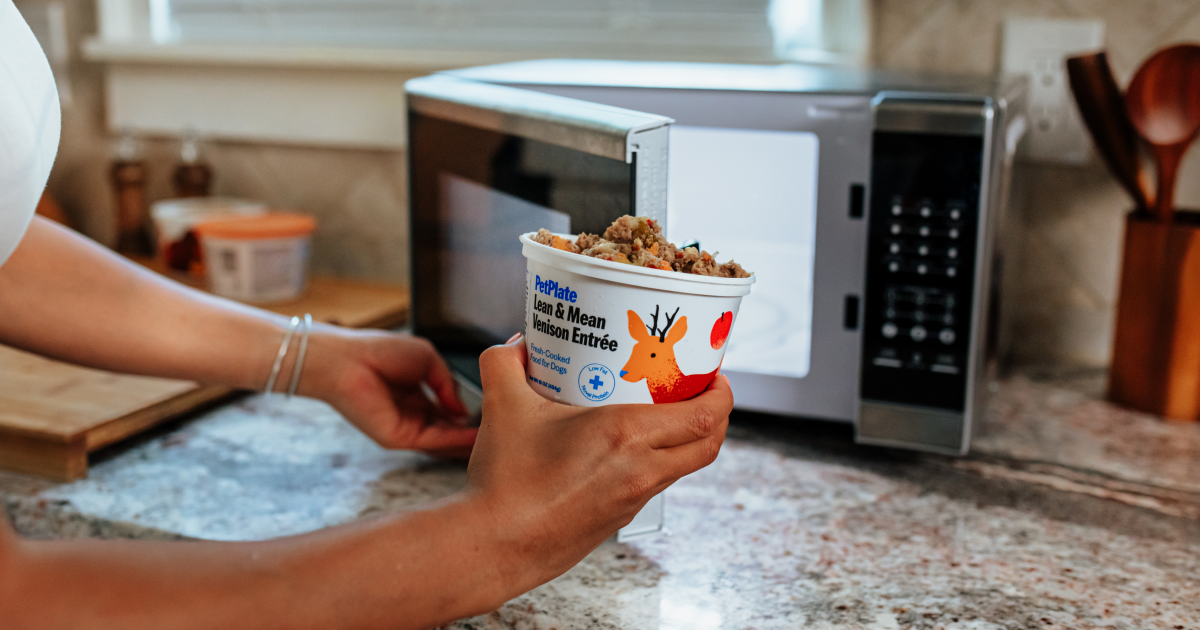Dog Gut Health + How to Improve Your Dog’s Gut Microbiome
Most dogs don’t let us forget the importance of the belly—rubbin’ it and fillin’ it. But your dog’s digestive system does more than turn food into fuel in order to power zoomies! Keeping it happy and functioning efficiently can impact everything from your dog’s joint health to their mood to the tear stains below their eyes.
While research is still very much in the puppy stage on the connection between a dog’s gut and the rest of their systems, it’s already clear that keeping the belly of the beast healthy is key to overall health. Read on to learn more—and what you can do to help keep your dog’s gut happy.
What Is Gut Health And The Gut Microbiome?
 Like our gut, the dog’s gut is filled with trillions of tiny critters like bacteria, fungi, protozoa and viruses, microbes that make up a community called the microbiome. There are about 10 times more organisms in the intestinal tract than total cells in a dog’s body—and they’re busy.
Like our gut, the dog’s gut is filled with trillions of tiny critters like bacteria, fungi, protozoa and viruses, microbes that make up a community called the microbiome. There are about 10 times more organisms in the intestinal tract than total cells in a dog’s body—and they’re busy.
In a healthy gut, the “good” bacteria keep the “bad” bacteria in check. They help with digestion and nutrient absorption. They help synthesize vitamins. They are linked to inflammation. And they have a profound impact on immunity—80% of a dog’s immune system resides in the gut. That’s true for humans as well.
“Dog and human microbiomes are surprisingly very similar,” says Dan Su, MS, DVM, DACVIM, a board certified veterinary nutritionist at BSM Partners. The two species have been living, eating and co-evolving together since the Paleolithic era, so it’s natural for them to have similar bacteria in their microbiomes.
“They’re made up of the very same bacterial species,” continues Su. “The difference is in the strain level.”
In recent years, buzz around the human microbiome has gotten louder as more research revealed connections between gut health and issues from mood and sleep to metabolism and cognition. Technologic advances empowered scientists to take a closer look at all these microbes and they were stunned by the complexity, according to Morris Animal Foundation, which has been conducting microbiome research on a number of different animal species. The number of human microbiome studies exploded.
And more and more of those studies suggest that the composition of the gut microbiome has a tremendous effect on overall health beyond the gastrointestinal tract. Human studies have demonstrated that many diseases seem to be influenced by microorganisms living in the gut, including autoimmune diseases, mental disorders and cancer.
“Canine science in this area is still in its infancy,” stresses Su, and the potential is exciting. Especially as the similarity between dog and human microbiomes could mean more research investment by firms seeking information about the power of the human gut, that could end up yielding results used to help dogs too.
The Importance of Gut Health for Dogs

When the balance of good and bad bacteria is maintained in a healthy microbiome, it’s able to help keep the body’s other systems running smoothly. “The gut is constantly sending neurons and hormones to deliver information to the brain, and vice versa, in what’s known as the gut-brain axis,” says Su. “It’s the communication system between the microbiome and the brain.”
Research has revealed fascinating connections between the microbiome and dog behavior. One University of Oregon study found a clear link between aggressive behavior in dogs and the microbes living in their guts. It did not explain if or how a dog’s gut microbiome’s causes aggression, only that there are associations between how a dog acts and the microbes it hosts. But it could be an important step toward more effectively dealing with a behavior issue that often leads to dogs being relinquished and even euthanized.
“It lays the foundation for how aggression and gut microorganisms may be connected,” said lead author Nicole Kirchoff, a graduate student in microbiology in the OSU College of Science.
Research has also found changes in the types of gut bacteria when animals are exposed to stress, such as being separated from their mothers too early, social stress and prolonged restraint. An Italian study looked at the gut microbiome and adrenal gland activity in dogs with aggression and fear-related behavioral issues, and found evidence supporting “intriguing opportunity” for mitigating behavior by rebalancing microbes in the gut.
Factors That Can Affect Dog Gut Health

When all the tiny critters in the gut are not living in perfect harmony, it’s called an imbalance, or dysbiosis. This could mean there are not enough helpful bacteria, there are too many harmful bacteria, there’s not enough diversity among the bacteria community—or a combination of these situations. Lots of factors can cause dysbiosis, including disease, age, exercise level, environment and medications. What we put into the dog’s gut—food—plays a huge role in maintaining the microbiome balance and overall gut health.
A poor-quality diet can disrupt a dog’s microbiome in several ways. First, it’s highly processed. We don’t want to feed our pups overly processed food for the same reasons experts tell us to stay away from them. Certain highly processed dog foods, like commercial kibble, are industrial creations that contain ingredients like additives to enhance taste, texture, color and flavor, which may contain toxins that harm the microbiome.
Antibiotics can also wreak havoc with the microbiome—and not just the antibiotics vets prescribe for dogs. By design, antibiotics kill bacteria. But they can wipe out far more than just the targeted microbes—they kill lots of helpful ones, too. About 70% of medically important antibiotics in the U.S. is sold for use on farms and used mostly as feed additives. So, if your dog eats low-quality commercial dog food, it is likely that those antibiotics—as well as genetically modified ingredients (GMOs)— are passed along to them.
The process used to manufacture commercial kibbles creates additional nasty compounds that are harmful to gut health. “When proteins and carbohydrates interact in a very high heat environment, it creates advanced glycation end products, or AGEs,” says Su. “It’s like if you’re searing a steak on the grill, AGEs are the crusty bits.”
AGEs are absorbed in the gut, then enter the circulatory system where they are distributed all over the body. This is bad news, because AGEs are big, stubborn molecules that don’t degrade easily. Instead, they accumulate—and get up to no good. Studies are beginning to reveal the numerous negative effects these compounds have on health in dogs—and humans.

They kick off inflammatory responses, creating a state of chronic systemic inflammation (associated with cancer), including inflammatory bowel disease (an allergic response in the gut). They can mess with the immune system. They make it more difficult for the body to repair tissues. Increased levels of AGEs have been seen in dogs with diabetes, cataracts, osteoarthritis, canine cognitive dysfunction syndrome, vascular dysfunction and atherosclerosis.
And while dogs’ bodies make a certain level of AGEs on their own and can eliminate them in low amount of the ones they may ingest, when they eat a lot of them they can’t keep up and the AGEs begin to accumulate. And you want AGEs even less than you want fleas.
“Just as it’s not a big deal if we just eat something fried or seared once in a while, but if you do that every day, you’re definitely taking in more than your body can work to eliminate,” says Su. “When dogs eat too many AGEs, it can potentially alter the gut micro flora and structure, the cell membranes and basically damage the integrity of the structures in and around the cells.”
And, most kibbles are not just heat processed once. The average bag of commercial dry food contains ingredients that have undergone high-heat processing an average of four times. So, a lot of AGEs end up in a bowl of commercial kibble. And a ton of AGEs end up in a dog who eats commercial kibble twice a day, 365 days a year. Nutritionally, it’s kind of like eating McNuggets every meal for a year.
Symptoms of an Unhealthy Gut

Because a well-functioning microbiome is important for maintaining the health of so many of the body’s other systems, symptoms of an imbalanced microbiome—or dysbiosis—can be varied, and include:
- Vomiting
- Diarrhea
- Skin issues- itching, chewing on feet, dry skin, dull coat
- Weight loss or obesity
- Chronic inflammation
- Dementia
- Stinky and increased flatulence
- Tear stains
- Bad breath
If you notice these symptoms, talk to your vet. “Do the same if you see a lasting change in your dog’s poop or pooping behavior,” says Su. For what to keep an eye out for, check out our blog on what your dog’s poop can tell you about their health!
Your vet can determine if gut health may be an issue, or if these symptoms are red flags for a different issue. Your vet clinic can analyze a poop sample from your dog to help determine the health of their microbiome.
How to Improve Your Dog’s Gut Health
Nutrition is one of the keystones of gut health—and overall health. Feeding your dog a diet of minimally-processed, balanced, nutrient-rich ingredients can help them regain and maintain happy harmony among all those gut bacteria. It’s one of the most powerful things you can do to enhance your dog’s gut health.
“Exercise may also help boost your dog’s gut health,” says Su. “While not much research has been conducted among dogs about this, human and mouse research shows that exercise impacts gut health in a very positive way.” It’s a good excuse to add 10 minutes to every walk.
Fresh Dog Food

The less the ingredients in a dog’s food are processed—and the closer they come to fresh—the healthier that food is. In general, gently-cooked foods contain fewer harmful AGEs and nasty ingredients like preservatives and antibiotics, and are easier for dogs to digest than overly-processed kibble.
But just because a dog food is fresh doesn’t make it the healthier choice for your dog’s gut health—and overall health. The food has to be formulated to deliver a complete and balanced profile of nutrients for your dog. After all, broccoli is fresh, but you can’t live on broccoli alone, right?
Pet parents need to consider their pup’s macro and micronutrient needs as well as the right balance of vitamins and minerals. They have to think about the quality of all those fresh ingredients. It’s a lot to consider. That’s why preparing fresh food for your dog yourself can be risky. In fact, 95% of homemade dog diets studied by UC-Davis researchers didn’t meet dogs’ nutrient needs.
Supplements

“Dietary supplements like probiotics may also help support gut health—particularly after a round of vet-prescribed antibiotics,” says Su. Ingredients like probiotics, prebiotics and postbiotics can help rebalance the microbiome.
Naturally occurring in foods like yogurt, probiotics are live, beneficial microbes. Think bacteria and yeast. Prebiotics are compounds that feed the probiotics and help them work more effectively. Postbiotics are beneficial molecules made when the probiotics break down the prebiotics. Packed with probiotics, PetPlate’s Tummy Ticklin’ Digestive supplements are an easy, organic, and yummy way to give your pup’s microbiome a bacterial boost!
The Benefits of Improved Dog Gut Health
- Evidence of good gut health can be found from nose to tail and can include:
- More energy, as nutrients are more efficiently used
- Fewer vet visits thanks to a stronger immune system
- Better poops resulting from healthier digestion
- Fewer yeast infections in ears and skin
- Behavioral changes like reduced anxiety
- Less licking, itching and scratching thanks to healthier skin and coat
- Shinier coat
- Lovelier aroma (better breath and reduced flatulence)
Dog Gut Health FAQs

How can I improve my dog’s gut health?
Make sure they get a daily diet of exercise and complete and balanced food that has been as minimally processed as possible.
How do I know if my dog has an unhealthy gut?
Poop changes are not the only symptoms of an unhealthy gut. Because the gut microbiome is so critical to the body’s overall function, red flags can range from chronic skin issues to tear stains on their furry face.
What foods are good for dog gut health?
The more minimally processed a food is, the better it is for dog gut health. Look for foods with wholesome, real ingredients in meals formulated by veterinarians. In addition, probiotic-packed foods like yogurt help support gut health.
What causes poor gut health in dogs?
A poor quality diet, along with disease, age, exercise level, stress, environment, and medications can all cause poor gut health in dogs.
Promote a Healthy Gut Microbiome for Your Dog with PetPlate

PetPlate offers complete, microbiome-friendly nutrition. Each gently-cooked recipe is specifically created for optimum health by a veterinary nutritionist, and delivered directly to your door. It’s made with human-grade ingredients and kettle-cooked in USDA kitchens following the same safety standards used to make human food.
In addition, PetPlate customizes plans for each dog based on age, weight activity level and other factors to optimize each bowlful of tasty nutrition. All six PetPlate entrees are designed to help support your dog’s gut health. Lean & Mean Venison is especially easy to digest, and formulated for dogs with protein sensitivities.
Clearly, improved gut health can transform your dog’s overall health and happiness. And it can deliver bennies way beyond a full belly. Which your dog says you should rub now, by the way!
